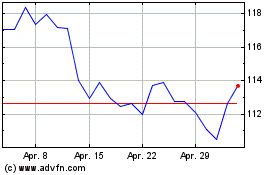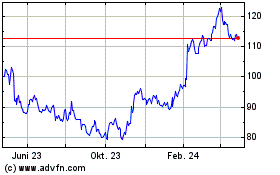Disney's 'Mulan' Plan Provokes These Questions
06 August 2020 - 1:14AM
Dow Jones News
By R.T. Watson and Joe Flint
In the latest pandemic-inspired Hollywood shake-up, Walt Disney
Co. on Tuesday said it would offer its live-action remake of
"Mulan" for sale Sept. 4 exclusively on its new streaming service,
Disney+, at about $30 a pop, instead of in theaters as planned.
Other studios have moved movie premieres' online in recent months
-- winning few friends among theater operators. But none has done
so in this particular way, as a premium-priced add-on for streaming
customers already paying a monthly fee for otherwise
all-you-can-eat entertainment.
For now, though, it's unclear whether Disney's move was a
one-time response to extenuating circumstances created by a global
public-health crisis, as Chief Executive Bob Chapek suggested
Tuesday on a conference call with Wall Street analysts, or a sign
of things to come.
How many people have to watch "Mulan" via Disney+ for the
company to make as much as it would have releasing it in
theaters?
Debuting a $200 million movie on a proprietary, premium
video-on-demand service is without precedent, so there's no clear
way to estimate how online sales of Disney's "Mulan" would stack up
against a hypothetical run in theaters. At $29.99 on Disney+, it
would take about 3.3 million transactions to generate $100 million
in revenue, which is roughly equal to $200 million at the domestic
box office -- about average for recent live-action Disney remakes
-- where ticket sales are split roughly in half between studios and
theaters.
A strong theatrical run for "Mulan" in places where Disney+
isn't available -- including China, the world's second-largest box
office market -- would complement what the studio earns on the film
through its service. "Mulan," which is based on an ancient Chinese
folk tale, could generate strong ticket sales in China.
Why has Disney chosen to make "Mulan" available exclusively on
its own streaming service, rather than also using popular
video-on-demand platforms operated by Apple Inc., Amazon.com Inc.
or others?
Disney's top priority is strengthening Disney+. By offering
"Mulan" there and only there, it not only keeps all the revenue,
instead of having to share it with middlemen, Disney+ could also
attract new subscribers, who pay about $7 a month for the
service.
Will other streaming services consider a similar "pay-per-view"
strategy?
Don't look for Netflix Inc. to charge extra to watch "The
Irishman II." With nearly 200 million subscribers world-wide,
Netflix has a huge customer base whose monthly payments can more
easily cover the costs of producing an expensive movie. Disney+, on
the other hand, is still in growth mode -- and putting the
big-budget "Mulan" on the service at no extra cost could increase
the risk for Disney. And Disney is one of the few brands that is so
popular it can probably get away with this sort of move without
alienating customers -- at least once.
How big a blow is this to theater owners?
Canceling a U.S. theatrical run for "Mulan" further spoils this
year's already corrupted movie calendar, which has suffered from a
series of delays including summer blockbusters like Universal
Pictures' "F9" and Paramount Pictures' "Top Gun: Maverick" moving
to next year.
For months, both major and independent American theater chains
have had their eye on two releases: Warner Bros.' "Tenet" and
Disney's "Mulan." Many theater owners hoped these two films would
lift ticket sales, in addition to spurring a resurgence in
moviegoing.
Most theaters are currently planning to open in mid- to late
August, ahead of a limited release of "Tenet," planned for Labor
Day weekend.
From a customer perspective, what are the pros and cons of
paying $30 to watch a major new movie at home, as opposed to seeing
it in a theater?
If "Mulan" were following a traditional rollout in U.S.
theaters, it would have certainly attracted a fair number of
families, meaning parents taking children to the theater, paying an
average $9 a ticket, plus popcorn, drinks and parking.
Compared with that outlay, $30 could represent a bargain.
Eventually the movie is expected to become available to all Disney+
users as part of their normal subscription, according to a person
familiar with the matter -- which could represent an even better
bargain for families willing to wait.
Write to Joe Flint at joe.flint@wsj.com
(END) Dow Jones Newswires
August 05, 2020 18:59 ET (22:59 GMT)
Copyright (c) 2020 Dow Jones & Company, Inc.
Walt Disney (NYSE:DIS)
Historical Stock Chart
Von Mär 2024 bis Apr 2024

Walt Disney (NYSE:DIS)
Historical Stock Chart
Von Apr 2023 bis Apr 2024
